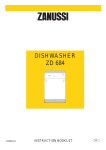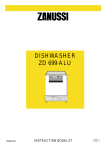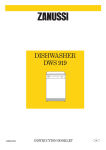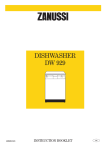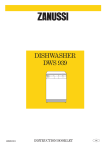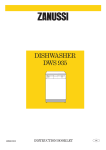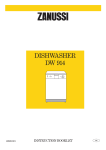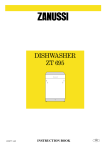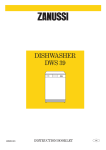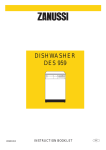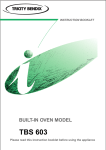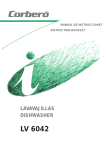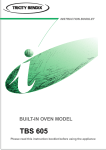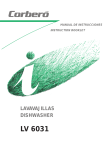Download Zanussi ZD 686 Instruction Booklet
Transcript
DISHWASHER ZD 686 152980 57/0 INSTRUCTION BOOKLET UK Contents For the user For the installer Important safety information 3 Description of the appliance 4 The control panel 4 Before use Setting the water softener Filling with salt Rinse aid 5 5 6 7 Using your appliance Loading your appliance The lower basket The cutlery basket The upper basket Adjusting the height of the upper basket Use of detergent 8 8 8 8 9 9 10 Hints and tips 11 Washing programmes 12 Operating sequence 13 Maintenance and cleaning Internal cleaning Cleaning the filters External cleaning Prolonged periods of non-operation Frost precautions Moving the machine 14 14 14 15 15 15 15 Something not working Service and spare parts Customer Care Department 16 17 17 Guarantee conditions 18 Zanussi Service Force 19 Hints for test centres Technical specifications 21 21 Installation instructions Water supply connections Water outlet hose connection Electrical connection 22 22 23 24 Building-in 25 Guide to use the instruction book The following symbols will be found in the text to guide you throughout the instructions: Safety instructions 1. 2. 3. Step by step Hints and tips Environmental information 2 IND35en Important safety information It is most important that this instruction book should be retained with the appliance for future reference. Should the appliance be sold or transferred to another owner, or should you move house and leave the appliance, always ensure that the book is left with the appliance in order that the new owner can get to know the functioning of the appliance and the relevant safety information. This information has been provided in the interest of your safety. You MUST read it carefully before installing or using the appliance. Installation ● This appliance is heavy. Care should be taken when moving it. ● It is dangerous to alter the specifications or attempt to modify this product in any way. ● Care must be taken to ensure that the appliance does not stand on the electrical supply cable. ● Any electrical work required to install this appliance should be carried out by a qualified electrician or competent person. ● Do not sit or stand on the open door. ● Isolate the appliance from the power supply and turn off the water supply after use. ● Care should be taken when cleaning the bottom door seal and hinge area as any exposed metal edges may cut if care is not taken. ● This product should be serviced by an authorised Service engineer, and only genuine spare parts should be used. ● Under no circumstances should you attempt to repair the machine yourself. Repairs carried out by inexperienced persons may cause injury or serious malfunctioning. Contact your local Service Force Centre. Always insist on genuine spare parts. Any plumbing work required to install this appliance should be carried out by a qualified plumber or competent person. Child Safety ● ● Conservation This appliance is designed to be operated by adults. Children should not be allowed to tamper with the controls or play with the product. ● Keep all packaging well away from children. ● Keep all detergents in a safe place out of children's reach. In the interest of the environment: ● Materials marked with the symbol recyclable. ● Check with your local Council or Environmental Health Office to see if there are facilities in your area for re-cycling this appliance. ● When the appliance is to be scrapped, cut off the power supply cable and make the door closing device unusable to prevent young children from being trapped inside. ● Help to keep your country tidy - use authorised disposal sites for your old appliance. During Use ● Items that are contaminated by petrol, paint, steel or iron debris, corrosive, acidic or alkaline chemicals must not be washed in this dishwasher. ● Under no circumstances should you open the door whilst the appliance is in operation. Always turn off the appliance before opening the door. ● Only use detergent specifically designed for use in dishwashers. ● Long bladed knives stored in an upright position are a potential hazard. ● Long and/or sharp items of cutlery such as carving knives must be positioned horizontally in the upper basket. ● When finishing loading or unloading close the door, as an open door can be a hazard. 3 are AVV01en Description of the appliance 1. Water hardness adjustment 2. Levelling spacers 3. Upper basket stop 4. Salt container 5. Lower spray arm 6. Detergent dispenser 7. Control panel 8. Rating plate 1 9. 2 13 3 12 4 5 11 6 10 Rinse aid dispenser 10. Large filter 9 11. Central filter 8 12. Upper spray arm 13. Upper basket 7 IN85 The control panel A 1. On/Off indicator light 9. Programme sequence indicator As the programme progresses, the programme selector dial turns, to show the phase in the wash programme the appliance has reached. 2. On/Off push button 3. BIO push button Prewash /Rinse and hold 4. INTENSIVE push button Wash 5. Door handle Cold rinse 6. Salt refilling indicator light Hot rinse 7. Programme marker Drying 8. Programme selector dial 10. Programme guide 4 APP146en Before use Before using your dishwasher for the first time: 1. Ensure that the electrical and water connections comply with the installation instructions 2. Remove all packaging from inside the appliance 3. Set the water softener 4. Pour 1 litre of water inside the salt container and then fill with salt 5. Fill the rinse aid dispenser. 6. Run a "Rinse and Hold" programme. Water hardness Setting the water softener The dishwasher is equipped with a water softener designed to remove minerals and salts from the water supply, which would have a detrimental or adverse effect on the operation of the appliance. The higher the content of these salts, the harder your water is. Water hardness is measured in equivalent scales, Clarke, French degrees and PPM (parts per Million). The softener should be adjusted according to the hardness of the water in your area. Your local Water Authority can advise you on the hardness of the water in your area. The dishwasher is factory set at level 2. If this level is not suitable for your area the softener should be adjusted. Clarke degrees French degrees (°TH) PPM (Parts per Million) Level Use of salt 0-6 0-8 0 - 80 0 NO 7 - 14 9 - 20 81 - 200 1 YES 15 - 28 21 - 40 201 - 400 2 YES 29 - 42 41 - 60 401 - 600 3 YES 43 - 56 61 - 80 601 - 800 4 YES 57 - 63 81 - 90 801 - 900 5 YES If your water is level 0 it is already soft and therefore there is no need to use salt. In this case adjust the water softener on level 1 without using salt. The salt indicator light on the control panel will always remain illuminated when the machine is switched on. With a screwdriver turn the selector on the upper front corner of the machine until the level required corresponds with the marker. 3 4 To adjust the water softener 5 2 2 1 AA05 5 PDU21UKen Filling with salt Only use salt specifically designed for use in dishwashers. All other types of salt not specifically designed for use in a dishwasher, especially table salt, will damage the water softener. Only fill with salt just before starting one of the complete washing programmes. This will prevent any grains of salt or salty water, which may have been spilled, remaining on the bottom of the machine for any period of time, which may cause corrosion. To fill: 1. To fill with salt, unscrew the cap of the salt container. 2. Pour 1 litre of water inside the container (this is necessary only before filling with salt for the first time). 3. Using the funnel provided, pour in the salt until the container is full. Do not worry if water over flows from the unit when filling with salt, this is quite normal. LE SA LT SA LZ SA L SE 4. Replace the cap making sure that there is no trace of salt on the screw thread or on the gasket. 5. Screw on the cap tightly. The salt container will require topping up periodically. SR06 You are reminded of this by the salt indicator light on the control panel which comes on when the salt has finished. The salt indicator light on the control panel can remain illuminated for 2-6 hours after the salt has been replenished, assuming the dishwasher remains switched on. If you are using salts that take longer to dissolve then this can take longer. The function of the machine is not affected. 6 SAL01en Rinse aid Rinse aid is automatically added during the last rinse, ensuring thorough rinsing, and spot and streak free drying. The dispenser, which is positioned inside the door, holds about 110 ml of rinse aid, which is sufficient for 16 - 40 dishwashing programmes, depending upon the dosage setting. Filling with rinse aid 1. Open the container by turning the lid (A) anticlockwise. 2. Add the rinse aid until the container is completely full. The indicator (B) will be completely dark. A 3. Top up the rinse aid when the indicator (B) becomes clear. BR01 Ensure that the lid is closed after every refill. Do not put liquid detergent in the rinse aid compartment. Clean up any rinse aid spilt during filling with an absorbent cloth to avoid excess foaming during the next wash. x 6 5 4 3 2 1 m a B Adjusting the dose According to the finish and drying results obtained, adjust the dose of rinse aid by means of the 6 position selector (C) (position 1 minimum dosage, position 6 maximum dosage). Start from position 3. Gradually increase the dose if there are drops of water or lime spots on the dishes after washing. Reduce it if there are sticky whitish streaks on the dishes. BR03 x 6 5 4 3 2 1 m a C BR02 7 BRI01en Using your appliance Loading your appliance Before placing dishes in the machine, remove any scraps of food, to avoid clogging the filters and consequently reducing the performance. Do not load very small items which can fall through the baskets. Open the door and slide out the baskets to load the dishes. UI48 The lower basket The lower basket is designed to take saucepans, lids, plates, salad bowls, cutlery etc. Serving dishes and large lids should be arranged around the edge of the basket, ensuring that the upper spray arm can turn freely. The two rear rows of prongs on the lower basket can be easily lowered to allow you to load pots, pans and bowls. UI21 To lower the prongs: - Slightly pull them upward and let them drop down (see picture). - To bring them back to the standing position, just pull them up again. The cutlery basket UI18 Long bladed knives stored in an upright position are a potential hazard. Long and/or sharp items of cutlery such as carving knives must be positioned horizontally in the upper basket. Take care when loading or unloading sharp items such as knives. Cutlery should be placed in the removable cutlery basket with the handles facing downwards. If the handles protrude from the bottom of the basket, obstructing the lower spray arm, load the cutlery with the handles facing upwards. Mix spoons with other cutlery to prevent them from sticking together. The cutlery basket is in two parts which can be separated to give greater loading flexibility. To separate the two parts, slide them horizontally in opposite directions and pull them apart. To reassemble, reverse the procedure. UI62 8 CES01en The upper basket The upper basket is designed for plates (dessert plates, saucers, dinner plates of up to 24 cm in diameter), salad bowls, cups and glasses. If dishes are loaded in the upper basket, tilt them forwards. Arrange items on and underneath the fold-down cup racks so that water can reach all surfaces. Glasses with long stems can be placed upside down in the raised cup racks. For taller items, the cup racks can be folded upwards. Light items (plastic bowls etc.) should be loaded in the upper basket and arranged so they do not move. US29 Before closing the door, ensure that the spray arms can rotate freely. US70 Adjusting the height of the upper basket If washing very large plates (over 27 cm and up to 31 cm in diameter) you can load them in the lower basket after moving the upper basket to the higher position. To move to the higher position proceed as follows: 1. Pull out the basket until it stops. 2. Carefully lift both sides upwards until the mechanism is engaged and the basket is stable. When the top basket is in the higher position it will only take plates up to 20 cm in diameter and you will not be able to use the raised cup racks. To lower the basket to the original position proceed as follows: RC04 1. Pull out the basket until it stops. 2. Carefully lift both sides upwards and the allow the mechanism to drop back slowly, keeping hold of it. Never lift or lower the basket on one side only. After loading your machine always close the door, as an open door can be a hazard. 9 CES16en Use of detergent Only use detergents specifically designed for use in dishwashers. We recommend the use of Finish detergents which are available in the following options: Finish Double Action Tablets. Each tablet has the exact amount of detergent required, simply place in the dispenser. Finish Powder recommended for every day use. Finish Liquid Gel ideal for every day use. As the gel is extra gentle is it recommended for fine bone china. Min = 15 g Max = 30 g D If using powder detergents proceed as follows: 1. Open the dispenser lid by pulling the catch (D). 2. Add the detergent according to the recommended quantity given in the "Washing programmes" chart. As all detergents are not the same, you should also consult the instructions from the manufacturer of your brand. M M IN AX DE17 3. Always close the lid. 4. If the programme has a prewash add a little amount of detergent over the lid of the dispenser. (See "Washing programmes" chart). If using detergent in tablets proceed as follows: 1. For all programmes; place 1 tablet inside the detergent dispenser. 2. Always close the lid. DE02 3. For all programmes with prewash; place a portion of a further tablet on the lid of the detergent dispenser. Insufficient quantities of detergent will produce poor washing results, whereas an excessive amount of detergent will not improve washing results and is also wasteful. Using no more than the correct amount also contributes to reducing pollution. Compact detergents with enzymes In these compact powders the environmentally unfriendly components have been replaced by natural enzymes and other more biodegradable substances. The enzymes deploy their full dirt dissolving power at a temperature as low as 50°C. By choosing the "Bio" programmes you can therefore achieve the same cleaning results that would otherwise be achievable only with 65°C programmes and conventional detergents. 10 DET02UKen Hints and tips To save energy Items not suitable for dishwashers Place dishes in the machine immediately after every meal and wait until the dishwasher is full before washing. If necessary run the Rinse and Hold programme (see "Washing Programmes" chart) so that any food scraps do not become caked on the dishes while you are waiting to run the complete wash programme. Do not prewash dishes under running water. The following items should not be washed in the dishwasher (unless they are sold as dishwasher proof): - Cutlery with wooden or horn handles or glued parts - bronze cutlery - saucepans with wooden handles - aluminium ware - crystal ware - leaded glass - plastic items - antique or fine decorated china For best washing and drying results Before loading, remove all scraps of food and soak very heavily soiled pots and pans. Arrange saucepans, cups and glasses etc. upsidedown. Tilt items with convex or concave surfaces so that the water drains off easily. Avoid contact between the dishes as far as possible. Certain types of decoration can discolour when washed in a dishwasher. Crystal-ware and plastic objects, if not guaranteed dishwasher proof should be washed by hand. Certain types of glass can also become opaque after being washed several times in a dishwasher. A chemical reaction can occur between silver cutlery and stainless steel cutlery. As a precaution, do not wash together. Iron and cast iron objects can rust and stain other items. Aluminium tends to go black, copper, pewter and brass tend to stain. If in doubt check with manufacturer of the item. When buying new dishes, ensure that they are dishwasher proof. For best results we recommend the use of Finish detergents, rinse aid and salt. EASY POURING PACK N EW TION DOUBLE AC FOR A BRILLIANT SHINE L I Q U I D G E L P O W D E R RINSE C O N C E N T R AT E D D I S H WA S H E R D E T E R G E N T DE15 11 CON06UKen Washing programmes Programme INTENSIVE 70°C Degree of soil and type of soil Heavy soil. Crockery, cutlery, pots and pans Heavy soil. HEAVY SOIL Crockery, cutlery, 65°C pots and pans NORMAL SOIL 65°C Normal soil. Crockery and cutlery * BIO WITH Starting position of the programmer Required push buttons A + On/Off A On/Off Recommended quantity of detergent wash 25 g 25 g Cycle description prewash 10 g Hot prewash Main wash up to 65°C 2 cold rinses 1 hot rinse Active drying 5g Cold prewash Main wash up to 55°C 1 cold rinse 1 hot rinse Active drying / Main wash up to 65°C 1 cold rinse 1 hot rinse Active drying B On/Off Normal soil. Crockery and cutlery A BIO + On/Off 25 g 5g Cold prewash Main wash up to 50°C 1 cold rinse 1 hot rinse Active drying WASH 50°C Light soil. Crockery and cutlery C BIO + On/Off 30 g / Main wash up to 50°C 1 cold rinse 1 hot rinse RINSE AND HOLD Any. Partial load (to be completed later in the day). D On/Off / / 1 cold rinse, (to avoid food scraps from sticking together). PREWASH 50°C ** QUICK 30 g * Testing programme for EN 50242 (see "Hints for Test Centres). ** This is a special programme for quick washing a full load of lightly soiled dishes, glasses and crockery (except pots) so that you may re-use them promptly. 12 PRO10en Operating sequence 1. Check the filters 8. Ensure they are clean and properly positioned (see "Maintenance and cleaning"). 2. Check that there is rinse aid and salt 3. Load the dishes Start the programme Depress the On/Off push button. The On/Off indicator light will come on and the machine will start. If you wish to interrupt the washing programme at any time press this button again. 9. Remove any scraps of food. Pull the lower basket out and arrange the saucepans, plates and cutlery in it. Pull the upper basket out and arrange the plates, saucers, glasses and cups etc. in it. Slide the baskets back into the machine. At the end of the washing programme At the end of the programme the dishwasher will automatically stop. The On/Off indicator light remains on until the On/Off push button is depressed. 10. Switch off the dishwasher 4. Ensure that the spray arms can rotate freely. 5. Measure out detergent Switch off the dishwasher by pressing the On/Off push button and open the door. Wait a few minutes before removing the dishes; in this way they will be cooler and the drying will be improved. Empty the lower basket first and then the upper one; this will avoid water dripping from the upper basket onto the dishes in the lower one. Add the detergent into the dispenser according to the dosage quantity given in the "Washing programmes" chart. Close the detergent dispenser lid. 6. Close the dishwasher door 7. Set the programme When the washing programme has finished, it is recommended that the dishwasher is unplugged and the water tap turned off. Turn the programme selector dial clockwise until the letter of the programme you wish to select corresponds with the programme marker on the control panel. If necessary select the temperature of the main wash according to the instructions in the "Washing programmes" chart (see "Required push buttons"). In general it is not advisable to open the door while the machine is working; if the door is opened however, a safety device ensures that the machine stops. Important! Care must be taken if the door is opened during the hot phase or immediately after a programme has finished, as steam may escape. 13 SEQ12en Maintenance and cleaning Internal cleaning Ensure that the seals around the door, the detergent and rinse aid dispensers are cleaned regularly with a damp cloth. We recommend the use of Finish Dishwasher Cleaner every 3 months or run a 65°C wash without dishes using detergent. Regular use of Finish Dishwasher Cleaner cleans inaccessible parts, eliminates unpleasant food odours and helps prevent the build-up of limescale. Cleaning the central filter (After each wash) Scraps of food may accumulate in the drain filter (A) and should be removed by rinsing the filter under running water. To remove the drain filter - simply pull it out by the handle. A Once cleaned, refit the filter by pushing it back to its original position until it engages. MA04 MA19 Cleaning the large filter (Every week) If necessary clean the large filter (B) on both sides under running water, using a brush. To remove the large filter 1. Remove the spray arm by pulling it upwards on one side. 90° B C 2. Turn the column (C) anticlockwise by 90° and then slide out the filter. MA05 MA20 3. Once cleaned refit it following the above instructions in reverse order. 4. Ensure the filter is in its original position, the handle of the drain filter should be pointing towards the front of the appliance. MA21 MA18 The dishwasher must not be used without filters. Incorrect repositioning and fitting of the filters will produce poor washing results. Cleaning the filters is vital to ensure correct operation of the machine. 14 MAN04UKen External cleaning Clean the external surfaces of the machine and control panel with a damp soft cloth. If necessary use only neutral detergents. Never use abrasive products, scouring pads or solvent (acetone, trichloroethylene etc....). Prolonged periods of non-operation If you are not using the machine for any period of time you are advised to: 1. Unplug the appliance and then turn off the water. 2. Fill the rinse aid dispenser. 3. Leave the door ajar to prevent the formation of any unpleasant smells. 4. Leave the inside of the machine clean. Frost precautions Avoid placing the machine in a location where the temperature is below 0°C. If this is unavoidable, empty the machine, close the appliance door, disconnect the water inlet pipe and empty it. Moving the machine If you have to move the machine (moving house etc....): 1. Unplug it. 2. Turn the water tap off. 3. Remove the water inlet and discharge hoses. 4. Pull the machine out together with the hoses. Avoid over tilting the machine during transportation. 15 MAN03en Something not working Certain problems are due to lack of simple maintenance or oversights, which can be solved easily without calling out an engineer. Before contacting your local Service Force Centre, please carry out the checks listed below. Important: If you call out an engineer to a fault listed below or to repair a fault caused by incorrect use or installation a charge will be made even if the appliance is in guarantee. Symptom The machine will not start Solution ● ● ● The machine does not fill with water ● ● ● ● The door has not been properly closed. The plug is not properly inserted in the power socket. There is a power failure. Ensure the water tap is open. Ensure the mains water supply has not been cut off. The inlet hose may be squashed or bent. Reposition the hose. The inlet hose may be blocked. Switch off the water supply and clean the filter. The filters are blocked ● Clean the filters (refer to "Maintenance and cleaning"). The spray arms are not rotating ● Ensure the crockery is loaded correctly. The dishwasher will not drain ● The drain hose may be squashed or bent. Reposition the hose. The sink may be blocked. Clear any blockages. The drain hose extension is not correct. Follow the instructions for connecting to the waste. There is no vent in the end of the drain hose. ● ● ● The machine is noisy ● ● Dishes are rattling against each other, refer to “Loading your machine”. The spray arms are knocking against the dishes. Refer to "Loading your machine". The door is difficult to close ● The dishwasher is not level, or not properly built-in. Visible lime deposits or white film on the dishes ● ● Check that there is salt and that the salt cap is tight. Check that the right level of the water softener is set. The dishes are not quite dry ● The rinse aid has run out or too little is being used. The dishes are not clean (poor wash) ● The baskets are too full. The dishes have not been arranged properly. The spray arms do not rotate The spray arms are clogged. The filters are clogged. The filters are not in the correct position. Not enough detergent has been used or it is unsuitable. The detergent is old or has gone hard. The salt container cap is not properly closed. The washing programme selected is too gentle. ● ● ● ● ● ● ● ● ● 16 RIM05UKen If after all these checks, the problem persists, contact your local Service Force Centre, quoting the model and serial number. This information can be found on the rating plate located on the right hand side of the dishwasher door (see picture). Service and spare parts Prod.No. ........ Ser. No. ......... In the event of your appliance requiring service, or if you wish to purchase spare parts please contact your local Zanussi Service Force Centre by telephoning: RA01 Mod. ........ 08705 929929 Your telephone call will be automatically routed to the Service Force Centre covering your post code area. The addresses are listed on the following pages. Before calling out an engineer, please ensure you have read the details under the heading "Something Not Working". When you contact the Service Force Centre you will need to give the following details: 1. Your name, address and post code 2. Your telephone number 3. Clear and concise details of the fault 4. The model and serial number (found on the rating plate) 5. The purchase date Customer Care Department For general enquiries concerning your Zanussi appliance or for further information on Zanussi products please contact our Customer Care Department by letter or telephone at the address below or visit our website at www.zanussi.co.uk Customer Care Department Zanussi 55-77 High Street Slough Berkshire SL1 1DZ Tel: 08705 727727 (*) * calls to this number may be recorded for training purposes 17 GAR02en Guarantee conditions Standard guarantee conditions We, Zanussi, undertake that if within 24 months of the date of purchase this Zanussi appliance or any part thereof is proved to be defective by reason only of faulty workmanship or materials, we will, at our option repair or replace the same FREE OF CHARGE for labour, materials or carriage on condition that: ● The appliance has been correctly installed and used only on the electricity supply stated on the rating plate. ● The appliance has been used for normal domestic purposes only, and in accordance with the manufacturer’s instructions. ● The appliance has not been serviced, maintained repaired, taken apart or tampered with by any person not authorised by us. ● All service work under this guarantee must be undertaken by a Zanussi Service Force Centre. ● Any appliance or defective part replaced shall become the Company’s property. ● This guarantee is in addition to your statutory and other legal rights. Home visits are made between 8.30am and 5.30pm Monday to Friday. Visits may be available outside these hours in which case a premium will be charged. Exclusions This guarantee does not cover: ● ● ● ● Damage or calls resulting from transportation, improper use or neglect, the replacement of any light bulbs or removable parts of glass or plastic. Costs incurred for calls to put right an appliance which is improperly installed or calls to appliances outside the United Kingdom. Appliances found to be in use within a commercial environment, plus those which are subject to rental agreements. Products of Zanussi manufacture which are not marketed by Zanussi. European Guarantee If you should move to another country within Europe then your guarantee moves with you to your new home subject to the following qualifications: ● ● ● ● ● ● The guarantee starts from the date you first purchased your product. The guarantee is for the same period and to the same extent for labour and parts as exists in the new country of use for this brand or range of products. This guarantee relates to you and cannot be transferred to another user. Your new home is within European Community (EC) or European Free Trade Area. The product is installed and used in accordance with our instructions and is only used domestically, i.e. a normal household. The product is installed taking in account regulations in your new country. Before you move please contact your nearest Customer Care centre, listed below, to give them details of your new home. They will then ensure that the local Service Organisation is aware of your move and able to look after you and your appliance. France Senlis +33 (0) 44 62 29 99 Germany Nurenberg +49 (0) 911 323 2600 Italy Pordenone +39 (0) 1678 47053 Sweden Stockholm +46 (0) 8 738 79 50 UK Slough +44 (0) 1753 219897 Ireland Dublin +353 (0) 14090753 18 GAR05en Zanussi Service Force To contact your local Zanussi Service Centre telephone CHANNEL ISLANDS GUERNSEY JERSEY Guernsey Electricity PO Box 4 Vale, Guernsey Channel Islands Jersey Electricity Company PO Box 45 Queens Road St Helier Jersey Channel Islands JE4 8NY ORKNEY (M65) Corsie Domestics 7 King Street Kirkwall Orkney KW15 PERTH Hydro Electrical Inveralmond House Ruthervenfield Road Perth PH1 3AQ PERTH Graham Begg Unit 4 Airport Ind Estate Wick KW1 4QS (OWN SALES) SHETLAND SCOTLAND ABERDEEN (M05) 54 Claremont Street Aberdeen AB10 6RA (OWN SALES) SHETLAND AUCHTERMUCHY (M03) BLANTYRE (M07) 33A Burnside Auchtermuchy Fife KY14 7AJ Unit 5 Block 2 Auchenraith Ind Estate Rosendale Way Blantyre G72 0NJ DUMFRIES (M01) 93 Irish Street Dumfries Scotland DG1 2 PQ DUNOON (M67) Brair Hill 7 Hill Street, Dunoon Argyll PA23 7AL GLASGOW (M04) INVERNESS (M06) ISLE OF ARRAN (OWN SALES) ISLE OF BARRA (OWN SALES) ISLE OF BUTE 20 Cunningham Road Clyde Estate Rutherglen, Glasgow G73 1PP Unit 3B Smithton Indust. Est. Smithton Inverness IV1 AJ Arran Domestics Unit 4 The Douglas Centre Brodick Isle of Arran KA27 8AJ J Zerfah 244 Bruernish Isle of Barra Western Islands HS9 5QY Walker Engineering Glenmhor Upper Serpentine Road Rothesay Isle of Bute PA20 9EH ISLE OF LEWIS (M69) ND Macleod 16 James Street Stornoway Isle of Lewis PA87 2QW KELSO (M08) 2-8 Wood Market Kelso Borders TD5 7AX (OWN SALES) WHALSAY (OWN SALES) Tait Electronic Systems Ltd. Holmsgarth Road Lerwick Shetland ZE1 0PW Bolts Shetland Ltd. 26 North Road Lerwick Shetland ZE1 0PE 08705 929 929 NORTH EAST GATESHEAD (M39) Unit 356a Dukesway Court Dukesway Team Valley Gateshead NE11 0BH GRIMSBY (M42) 15 Hainton Avenue Grimsby South Humberside DN32 9AS HULL (M41) Unit 1 Boulevard Industrial Estate Hull HU3 4AY LEEDS (M37) 64-66 Cross Gates Road Leeds LS15 7NN NEWTON AYCLIFFE (M45) Unit 16 Gurney Way Aycliffe Industrial Estate Newton Aycliffe DL5 6UJ SHEFFIELD (M38) Pennine House Roman Ridge Ind. Roman Ridge Road Sheffield S9 1GB Leask Electrical Harlsdale Symbister, Whalsay Shetland ZE2 9AA NORTHERN IRELAND BELFAST (M27) Owenmore House Kilwee Buisness Park Upper Dunmury Lane Belfast BT17 0HD NORTH WEST BIRKENHEAD (M11) 1 Kelvin Park Dock Road Birkenhead L41 1LT CARLISLE (M10) Unit 7 James Street Workshops James Street Carlisle Cumbria CA2 5AH ISLE OF MAN (M64) South Quay Ind Estate Douglas Isle of Man IM1 5AT LIVERPOOL (M15) Unit 1 Honeys Green Precinct Honeys Green Lane Liverpool L12 9JH MANCHESTER (M09) Unit B Central Industrial Estate St Marks Street Bolton BL3 6NR PRESTON (M13) Unit 250 Dawson Place Walton Summit Bamber Bridge Preston Lancashire PR5 8AL STOCKPORT (M16) Unit 20 Haigh Park Haigh Avenue Stockport SK4 1QR WALES CARDIFF (M28) Guardian Industrial Estate Clydesmuir Road Tremorfa Cardiff CF2 2QS CLYWD (M14) Unit 6-7 Coed - Parc Abergele Road Rhuddlan Clwyd Wales LL18 5UG DYFED (M77) HAVERFORDWEST (M75) OSWESTRY (M17) Maes Y Coen High Mead Llanybydder Carmarthenshire SA40 9UL Cromlech Lodge Ambleston Haverfordwest Pembrokeshire SA62 5DS Plas Ffynnon Warehouse Middleton Road Oswestry SY11 2PP 19 GAR22en Zanussi Service Force To contact your local Zanussi Service Centre telephone MIDLANDS BIRMINGHAM (M18) 66 Birch Road East, Wyrley Road Ind. Estate Witton Birmingham B6 6DB BOURNE (M44) Manning Road Ind. Estate Pinfold Road Bourne PE10 9HT BRIDGNORTH (M72) 68 St. Mary’s Street Bridgnorth Shropshire WV16 4DR GLOUCESTER (M23) 101 Rycroft Street Gloucester GL1 4NB HEREFORD (M31) Unit 3 Bank Buildings Cattle market Hareford HE4 9HX HIGHAM FERRERS (M51) ILKESTON (M43) LEICESTER (M22) LINCOLN (M40) NEWCASTLE UNDER LYME (M12) REDDITCH (M20) 30 High Street Higham Ferrers Northants NN10 8BB Unit 2 Furnace Road Ilkeston DE7 5EP LONDON & EAST ANGLIA 11 a Gardener Ind. Estate Kent House Lane Beckenham Kent BR3 1QZ CHELMSFORD (M47) Hanbury Road Widford Ind. Estate Chelmsford Essex CM12 3AE COLINDALE (M53) Unit 14 Capitol Park Capitol Way Colindale London NW9 0EQ ELTHAM (M78) 194 Court Road Mottingham Eltham London SE9 4EW BARNSTAPLE (M30) 284 Alma Road Enfield London EN3 7BB Main Box Fremington Barnstaple North Devon EX31 2NT BOURNEMOUTH (M26) 63-65 Curzon Road Bournemouth Dorset BH1 4PW BRIDGEWATER (M35) 6 Hamp Ind. Estate Bridgewater Somerset TA6 3NT BRISTOL (M25) 11 Eldon Way Eldonwall Trading Bristol Avon BS4 3QQ EMSWORTH (M33) 266 Main Road Southbourne Emsworth PO10 8JL ISLE OF WIGHT (M34) Unit 8 Enterprise Court Ryde Buisness Park Ryde Isle of Wight PO33 1DB NEWTON ABBOT (M29) Unit 2 Zealley Ind. Estate Kingsteignton Newton Abbot S. Devon TQ12 3TD REDRUTH (M36) Unit 7D Pool Ind. Estate Wilson Way, Redruth, Cornwall TR15 3QW ENFIELD (M49) GRAVESEND (M57) Unit B4, Imperial Buisness Estate Gravesend Kent DA11 0DL Unit 7 Oaks Ind. Estate Coventry Road Narborough Leicestershire LE0 5GF Unit 4 Riverside Estate Coldharbour Lane Harpenden AL5 4UN LETCHWORTH (M50) Unit 8 Stonefield Park Clifton Street Lincoln LN5 8AA 16-17 Woodside Ind. Estate Works Road Letchworth Herts SG6 1LA LONDON (M76) 18-21 Croft Road Brampton Ind. Estate Newcastle under Lyme Staffordshire ST5 0TW 2/4 Royal Lane Yiewsley West Drayton Middlesex UB7 8DL MAIDENHEAD (M60) Reform Road Maidenhead Berkshire SL6 8BY MOLESEY (M61) 10 Island Farm Avenue West Molesey Surrey KT8 2UZ NEWBURY (M24) 9 Pipers Court Berkshire Drive Thatcham Berkshire RG19 4ER IPSWICH (M48) Unit 6C Elton Park Business Centre Hadleigh Road Ipswich IP2 0DD NORWICH (M52) 2b Trafalgar Street Norwich NR1 3HN SUNBURY (M63) Unit 1 a The Summit Hanworth Road Hanworth Ind Estate Sunbury on Thames TW16 5D TAMWORTH (M19) Unit 3 Sterling Park Claymore Tamworth B77 5DO WORCESTER (M73) Units 1 & 2 Northbrook Close Gregorys Mill Ind. Estate Worcester WR3 8BP SOUTH EAST BECKENHAM (M79) HARPENDEN (M46) 13 Thornhill Road North Moons Moat Redditch Worcestershire B98 9ND 08705 929 929 20 ASHFORD (M58) Unit 2 Bridge Road Buisness Est. Bridge Road Ashford Kent TN2 1BB FLEET (M59) Unit 1 Redsfield Ind. Estate Church Crookham Fleet Hampshire GU13 0RD HAYWARDS HEATH (M55) 21-25 Bridge Road Haywards Heath Sussex RH16 1UA SOUTH WEST GAR23en Hints for test centres Before starting any test it is necessary to fill completely with salt the salt container and with rinse aid the rinse aid dispenser. Test standard EN 50242 Reference programme: BIO 50°C WITH PREWASH Load: 12 standard place settings Rinse aid selector: position 5 Detergent dosage : 25 g in the dispenser 5 g on the dispenser lid US50 UI48 Arrangement upper basket Arrangement lower basket Technical specifications Dimensions Width Height with worktop Max depth Max depth with open door Electrical connection Motor rating during wash Power of heating element Overall power Voltage Water supply pressure Minimum Maximum Capacity 59.6 cm 81.8 - 87.8 cm 57 cm 111.4 cm 220/240 V - 50 Hz 200 W 2100 W 2300 W 50 kPa (0.5 bar) 800 kPa (8 bar) 12 place settings 21 IST35en Installation instructions Any electrical work required to install this appliance should be carried out by a qualified electrician or competent person. Any plumbing work required to install this appliance should be carried out by a qualified plumber or competent person. Remove all packaging before positioning the machine. If possible, position the machine next to a water tap and a drain. Water supply connections This dishwasher must be plumbed into a cold water supply. The water pressure must be within the limits given in the technical specifications. Your local Water Authority will advise you on the average mains pressure in your area. The dishwasher features fill and drain hoses which can be turned either to the left or the right to suit the installation. The locknut must be correctly fitted to avoid water leaks. Avoid bends or kinks in the hose which could prevent or slow down the water supply. If the machine is connected to new pipes or pipes which have not been used for a long time, you should run the water for a few minutes before connecting the inlet hose. This will prevent deposits of sand or rust clogging the inlet hose filter. 22 COL08en Water outlet hose connection 2 Ø Ø 1. To the sink outlet spigot, securing it if necessary with a clip. 18 21 1 min 4 cm The end of the drain hose can be connected in the following ways: min 30 cm max 100 cm 2. To a stand pipe provided with vent-hole, minimum internal diameter 4 cm. The waste connection must be at a height of between 30 cm (minimum) and 100 cm (maximum) from the bottom of the dishwasher. CS13 Ø 18 Ø 21 Ensure the hose is not bent or squashed as this could prevent or slow down the discharge of water. If you use a drain hose extension it must be no longer than 2 metres and its internal diameter must be no smaller than the diameter of the hose provided. + 2 m max min 30 cm max 100 cm The drain hose can face either to the right or left of the dishwasher CS14 Likewise the internal diameter of the couplings used for connections to the waste outlet must be no smaller than the diameter of the hose provided. The sink plug must not be in place when the machine is draining as this could cause the water to siphon back into the machine. Attention! Our appliances are supplied with a security device to protect against the return of dirty water back into the machine. If the spigot of your sink has a "no return valve" incorporated this can prevent the correct draining of your dishwasher. We advise you therefore to remove it. 23 COL12en Electrical connection This appliance must be earthed. The manufacturer declines any responsibility should this safety measure not be observed. If the plug that is fitted to your appliance is not suitable for the socket, it must be cut off and the appropriate plug fitted. Important The wires on the mains lead are coloured in accordance with the following code: Green and Yellow -Earth Blue -Neutral Brown -Live If you fit your own plug, the colours of the wires in the mains lead of your appliance may not correspond with the markings identifying the terminals in your plug. Proceed as follows: 1. Connect the Green and Yellow (earth) wire to the terminal in the plug which is marked with the letter "E" or the earth symbol or coloured green and yellow. 2. Connect the Blue (neutral) wire to the terminal in the plug which is marked with the letter "N" or coloured black. 3. Connect the Brown (live) wire to the terminal in the plug which is marked with the letter "L" or coloured red. CE03 The plug moulded onto the lead incorporates a 13amp BSI362 fuse. Only ASTA or BSI fuses should be used. The plug must not be used if the fuse cover/carrier is lost. The cover/carrier is indicated by the coloured insert at the base of the product. A replacement cover/carrier must be obtained from your local Service Force Centre. This appliance complies with the following E.E.C. Directives: - 73/23 or 19.2.73 (Low Voltage Directive) and subsequent modifications; - 89/336 or 3.5.89 (Electromagnetic Compatibility Directive) and subsequent modifications. 24 COLUKen Building-in This dishwasher is designed to be fitted under a kitchen counter or worksurface. No further openings for venting of the dishwasher are required, but only to let the water fill and drain hose and power supply cable pass through. 820 − 880 It is essential that the recess dimensions indicated in the diagram are followed. 596 818 − 878 5 57 x ma The recess height may be anywhere between 820 and 880 mm from the floor as the dishwasher incorporates adjustable feet (max 60 mm). A distance of 2 mm should be allowed between the top of the dishwasher and the counter top. 5 0 55 x ma 600 + II76 Adjusting the height of the appliance To adjust the height proceed as follows: 1. Loosen or tighten the two front feet. 2. The rear foot is adjusted by turning the screw in the middle of the front kick plate to the left or right. A pad is supplied for the rear foot to make sliding the appliance in and out of the recess easier. To fit the pad, press it onto the rear foot. If required, the dimensions of this pads can be reduced by breaking it where marked. II52 Good levelling is essential for correct closure and sealing of the door. When the appliance is correctly levelled, the door will not catch on the levelling spacers on either side of the cabinet. If the door does not close correctly, loosen or tighten the adjustable feet until the machine is perfectly level. IN11 25 IN12 INS59UKen The furniture door The door on this appliance is designed for the overlay of a panel having the following dimensions: Width Height Thickness Weight 596 mm 604 mm max 20 mm max 2 - 7.5 kg max The height of the panel depends on the height of adjacent kitchen units (see kitchen plinth adjustment). A The panel height should be no more than indicated, otherwise complete opening of the door will not be possible as the furniture door panel will hit against the dishwasher plinth. A II04 Furthermore, it is possible to line up the control panel to correspond with the height of the drawers of adjacent pieces of furniture, thus perfectly coordinating with style of the rest of the unit furniture in your kitchen. B X 1 Add one or more of the fillets provided until you reach the desired height. B = Secure the fillets as shown in the picture, by means of two screws 4 x 40 provided therewith. 55253 5 = 2 II113 II91 Prepare the panel as follows: 1. Measure the distance (B) between the part below the control panel (or fillets) and the reference notch (X) on the door. 2. Drill the panel with a Ø 2 x 14 bit according to the dimensions given in the picture. 3. Screw the two fastening pivots into the holes indicated in the picture. 4. Mount the decor panel by inserting the two fastening pivots into the slotted holes of the door. Lift the decor panel until perfect alignment with the fascia panel is obtained. II83 5. Once the correct position has been found, open the door and fasten the decor panel by means of the four 4 x 40 screws provided, using the holes through the inner door. II84 26 INS23en Fixing to the adjacent units Insert the two fixing brackets into the slots provided in the top front part of the dishwasher as shown in the figure. Secure the brackets to the adjacent units with the 3.5 x 16 screws using the upper or the side holes. Attention! The sides of the dishwasher must never be drilled to prevent damage to hydraulic components. The appliance must be secured to the underside of the worktop using the brackets provided. Failure to do this could cause damage or injury. II54 Noise protection Adhesive noise protection ensures excellent noise insulation. This should be fitted when the dishwasher has been mounted in the recess and the height adjusted. Apply the protection as shown in the drawing, making sure that the non-adhesive section reaches right down to the floor. II61 27 INS03en Kitchen plinth adjustment To allow correct opening of the door it is sometimes necessary to cut the kitchen plinth. Refer to the cutting table. According to dimensions (a) and (b) as shown on the figure, you will find on the following table the depth (x) of the cut to be made on the plinth. The dimensions (a) and (b) of the table are those most frequently used in the kitchen furnitures. II59 a II15 b Height (a)* 170 160 150 140 130 120 110 100 90 40 136 131 125 118 110 100 93 85 75 Depth (b)* 50 135 131 125 118 110 102 92 85 75 60 137 132 125 118 110 102 94 85 75 70 138 134 128 120 110 104 95 85 75 80 / 90 / / 100 / / X 139 130 124 115 105 98 88 78 (*) dimensions in mm 138 129 120 110 100 90 80 / 135 125 115 105 95 85 600 mm minimum X Dimensions of the cut on the plinth 28 INS34en From the Electrolux Group. The world’s No.1 choice. The Electrolux Group is the world’s largest producer of powered appliances for kitchen, cleaning and outdoor use. More than 55 million Electrolux Group products (such as refrigerators, cookers, vacuum cleaners, chain saws and lawn mowers) are sold each year to a value of approx. 14 billion USD in more than 150 countries around the world. © Electrolux Household Appliances Limited 2000
































